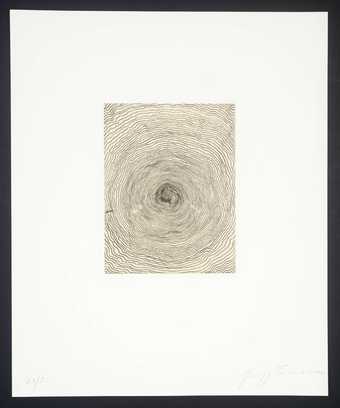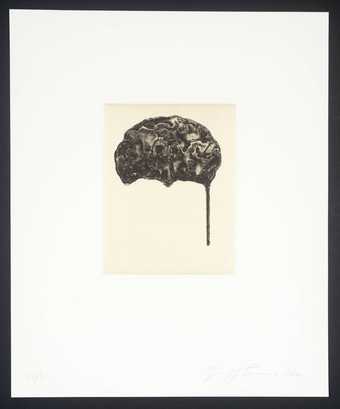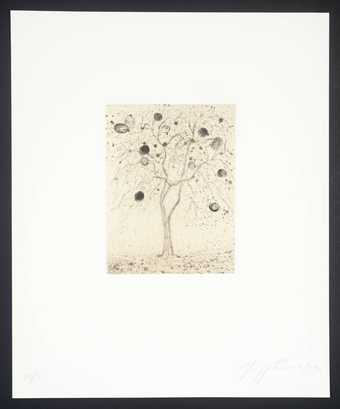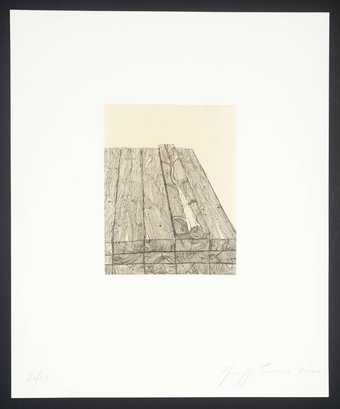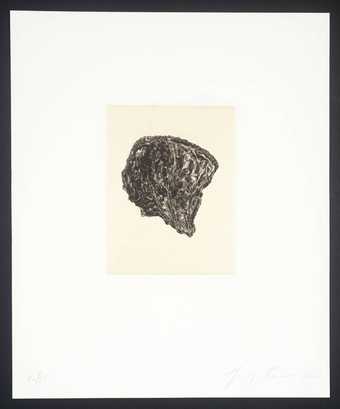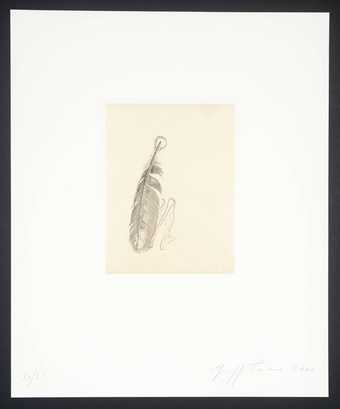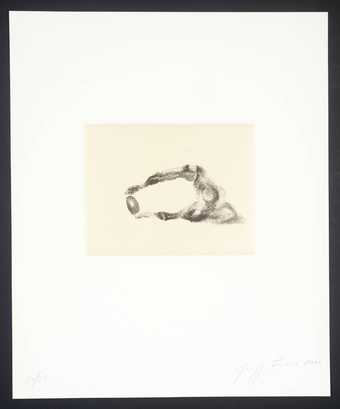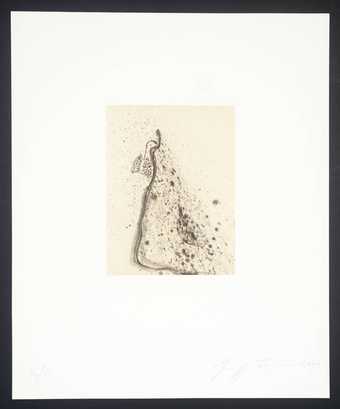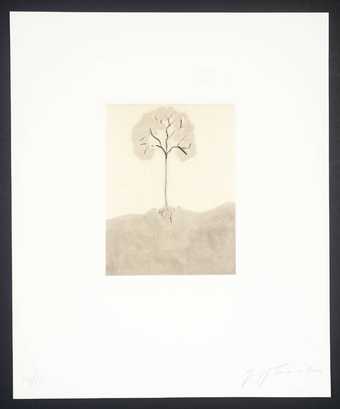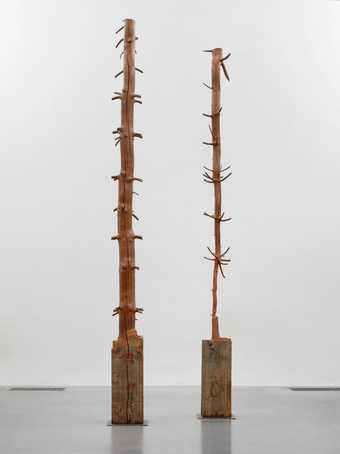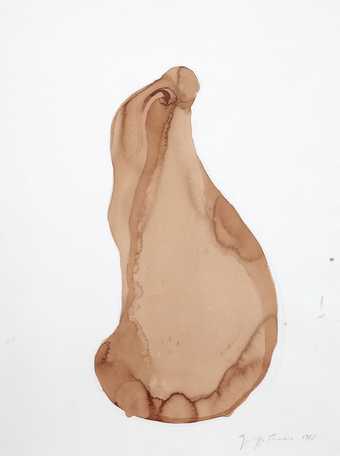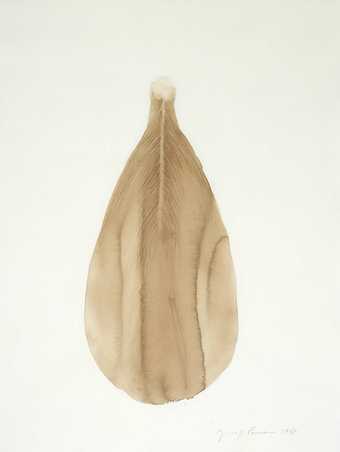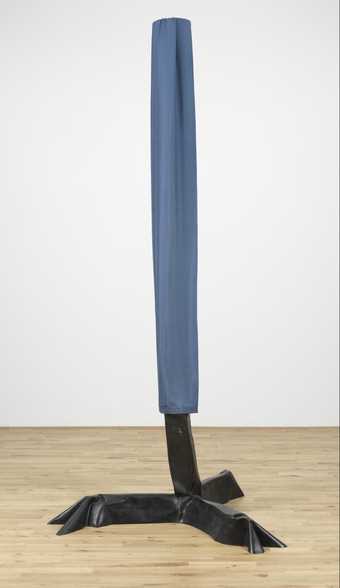In Tate Modern
- Artist
- Giuseppe Penone born 1947
- Original title
- Soffio 5
- Medium
- Clay
- Dimensions
- Object: 1540 × 830 × 840 mm
- Collection
- Tate
- Acquisition
- Purchased 1982
- Reference
- T03420
Summary
Breath 5 1978 is a large clay sculpture by the Italian artist Giuseppe Penone. Over one and a half metres tall, it stands upright and has a vase-like shape that is bulbous at the bottom and narrows towards the top. The work, which has a rough texture all over, consists of three approximately equal sections of brown terracotta clay, the joins between which are clearly visible as horizontal lines running around the sculpture. Interrupting the curved form of the ‘vase’ on one side is a narrow vertical passage that features a rippled imprint and rounded clusters of clay at its edges. This passage expands at the neck of the sculpture, and at the very top of the work a small mouth-like cavity is visible.
This work was made by Penone in the kilns of the Castellamonte pottery near Turin in northern Italy in 1978. The passage running down one side of the work is an imprint of the artist’s clothed body. Penone first made a cast of himself, against which he stacked coils of clay. He then removed the cast, leaving behind an impression of his body, before moulding swirling forms of clay around its edges. A clay cast of the inside of his mouth was added to the top of the sculpture. The overall effect, as evoked by the work’s title, is to suggest that this sculpture is a ‘breath’ taken by the artist as he leans forward with billowing forms of air around him.
Penone began making photographs, drawings and texts exploring the notion of breath in 1977, and this sculpture can be particularly related to two drawings titled Study for ‘Breath of Clay’ 1978 (Tate T06772 and Tate T06773). Breath 5 is one of nine large vase-like works in clay subsequently completed by Penone in 1978, with the others including Breath 1 1978 (Stedelijk Museum Amsterdam, Amsterdam) and Breath 6 1978 (Centre Georges Pompidou, Paris).
In a 2012 interview with the art historian Benjamin Buchloh, Penone discussed the ideas that underpinned his interest in breath:
When we breathe, there’s a volume of air that goes back into space, which is different from the volume of air around us, and that volume of air is a sculpture – a sculpture that lasts an instant, but is already a sculpture.
(Quoted in Benjamin Buchloh, ‘Interview with Giuseppe Penone’, in Busine 2012, p.16.)
Similarly, in 2015 the critic Thomas Marks discussed how the series of Breath sculptures evoke seemingly contradictory forces: ‘On the one hand, these pieces grant a monumental mass to what is momentary, but on the other they make visible a projection of the body into space that is a fundamental condition of being alive’ (Thomas Marks, ‘Force of Nature’, Apollo, vol.182, no.634, September 2015, p.62).
Born in 1947 in the village of Garessio in north-west Italy, Penone trained for a year at the Accademia di Belle Arte in Turin (1970). His early work was particularly concerned with sight, with the performance Reversing One’s Own Eyes 1970 involving the artist wearing reflective contact lenses as he struggled to orientate himself within natural surroundings. A recurring interest in vegetation and trees is evident in works such as the sculpture Tree of 12 Metres 1980–2 (Tate T05557), while Penone has returned to the notion of breath throughout his career. For instance, Breathing the Shadow, completed between 1999 and 2002, is a series of sculptures and installations that feature lungs and leaves cast in bronze and gold.
Penone’s work has commonly been associated with the development of arte povera, a term coined in 1967 by the critic and curator Germano Celant that relates to the work of Italian artists such as Alighiero e Boetti and Pino Pascali, who often employed everyday materials and conceptual gestures in resisting traditional artistic practices.
Further reading
Giuseppe Penone, exhibition catalogue, Stedelijk Museum Amsterdam, Amsterdam 1980, reproduced pp.18–19.
Germano Celant, Giuseppe Penone, Milan 1989, pp.23, 90–9, reproduced pp.94–5.
Laurent Busine (ed.), Giuseppe Penone, Brussels 2012, pp.46–93, reproduced pp.66–9.
Richard Martin
June 2016
Supported by Christie’s.
Does this text contain inaccurate information or language that you feel we should improve or change? We would like to hear from you.
Display caption
The clay is modelled on the imagined shape of a breath of air, exhaled from the artist’s mouth. At the top is the form of the interior of Penone’s mouth, squeezed into the clay. The impression along the side of the clay is of the artist’s leg, wearing jeans, as he leans forward. Penone has made many works concerning the impression of man on nature. For Breath Penone has spoken of the influence of mythological explanations of the creation of man.
Gallery label, January 2016
Does this text contain inaccurate information or language that you feel we should improve or change? We would like to hear from you.
Catalogue entry
T03420 Breath 5 1978
Terracotta 61 × 32 3/4 × 33 (1540 × 830 × 840)
Not inscribed
Purchased from Galerie Durand-Dessert, Paris (Grant-in-Aid) 1982
Exh: Galerie Durand-Dessert, Paris, June–August 1979 (no catalogue); Giuseppe Penone, Stedelijk Museum, Amsterdam, February–March 1980 (15, as ‘Soffio 5’, repr. in col.); Giuseppe Penone, Gewad, Ghent, 1980 (no catalogue); Identité Italienne, l'Art en Italie depuis 1959, Museé National d'Art Moderne, Centre Georges Pompidou, Paris, June–September 1981 (repr. p.618); Biennale de la Critique, Palais des Beaux Arts, Charleroi, December 1981–January 1982 and International Cultureel Centrum, Antwerp, January–February 1982 (catalogue not numbered); New Art at the Tate Gallery, Tate Gallery, September–October 1983 (repr. p.18); Falls the Shadow: Recent British and European Art, Hayward Gallery, April–June 1986 (not listed)
Lit: Germano Celant, ‘Die archetypischen Verbindungen bei Giuseppe Penone’, Giuseppe Penone, exhibition catalogue, Museum Folkwang, Essen, 1978, pp.29–62; Identité Italienne, l'Art en Italie depuis 1959, exhibition catalogue, Museé National d'Art Moderne, Centre Georges Pompidou, Paris, 1981, pp.582, 585 and 591; Marlies Gruterich, ‘Italienische Identität oder reiche arme Kunst’, Kunst-Bulletin des Schweizerischen Kunstvereins, February 1982, pp.2–9, repr. p.8; Giuseppe Penone, exhibition catalogue, Kunstmuseum, Lucerne, 1977, p.47; Jessica Bradley, ‘The Poetics of Representation’, Giuseppe Penone, exhibition catalogue, National Gallery of Canada, Ottawa, 1983, pp.10–15, repr. in col. on cover; Jessica Bradley, ‘La Vision poétique de Giuseppe Penone’, Giuseppe Penone, exhibition catalogue, ARC, Musée d'Art Moderne de la Ville de Paris, Paris, 1984, pp.9–14, repr. p.43
Also repr: Art 11, '80, Die internationale Kunstmesse Basel, June 1980, p.66; An International Survey of Recent Painting and Sculpture, Museum of Modern Art,New York, 1984, p.247
‘Breath 5’ is one of six similar terracottas of 1978, the first three made in the artist's studio in Turin, and the others at the pottery at Castellamonte, where they were all fired.
These sculptures, titled in Italian ‘Soffio’, are now in these collections:
1. Stedelijk Museum, Amsterdam
2. FER Collection, West Germany
3. Private collection, Italy
4. Galerie Rudolf Zwirner, Cologne
5. Tate Gallery
6. Musée National d'Art Moderne, Centre Georges Pompidou, Paris
Their first publication was the reproduction of two of them in the catalogue of the artist's exhibition at the Museum Folkwang, Essen, of September–October 1978. This catalogue is also illustrated with Penone's studies of breath in two types of drawing, one in the style of Leonardo da Vinci showing currents of air blown from the mouth like waves, and another showing studies of human lips, pursed as if to blow. These give a key to the subject of this sculpture.
The clay is modelled as if it were the imagined shape of a breath of air, shortly after being exhaled from the artist's mouth, when the first part of it has just reached the ground. The frontispiece of the Essen catalogue is a drawing by Penone of a man blowing into a funnel, with the pattern of air breaking over the surface in front of him like waves. The top of the Tate Gallery's sculpture represents the cavity of the funnel into which he is blowing, and in the centre of this uppermost section is the shape of the interior of his mouth, squeezed into the clay, and so making positive the shape of the air coming from his throat. Photographs in the catalogue show Penone taking a bronze cast of such a shape out of his mouth, to demonstrate what it represents. The impression along the side of the clay is of the artist's clothed body, as he leans forward to blow down to the ground. The Tate Gallery's version has the impression only of one leg, wearing jeans, as if he leaned forward on that one with the other stretched behind. The lumps at the edge of this impression represent billows of air rebounding from his body.
An explanation by the artist in the Essen catalogue enlarged the association of his clay breath with that of a god in the act of creation:
according to a myth the creator of man was the god Khnum, who is represented as a potter shaping man on his wheel. In another myth, Athena breathes life into men whom Prometheus had made from clay and water (translated from the French in Identité Italienne, l'Art en Italie depuis 1959, 1981, p.585).
Penone has often made works concerned with the direct impression of the human onto nature. Before making the ‘Breaths’ he was interested in an ancient terracotta vase, comparable to them both in the material used and in that he was fascinated by the fingerprints of the potter, apparently noticeable on the surface, which he enlarged as a relief. The clay of the ‘Breaths’ similarly receives the touch of the artist. The marks of the potter Penone compared also to the creation of man by God, since the creator's touch must leave his imprints on the surface of what he creates:
The hand that modelled man has left upon him the prints filled by water and air as our movements vary. Indeed, air in filling the prints re-creates the maker's skin; the skin of whoever touches the man tends to acquire at that point the shape of the maker's skin. With the negative of his skin impression one can make an infinite number of positives, just as many positives as there will be contacts with the surface of the future. (Giuseppe Penone, Kunstmuseum, Lucerne, 1977, p.78).
The breath of the artist was exhibited more directly in 1979, in the form of leaves on the gallery floor which he had blown into various shapes (Giuseppe Penone, ARC, Musée d'Art Moderne de la Ville de Paris, Paris, July–September 1983, repr. 17, ‘Souffle de feuilles’).
Published in:
The Tate Gallery 1982-84: Illustrated Catalogue of Acquisitions, London 1986
Explore
- abstraction(8,615)
-
- from recognisable sources(3,634)
-
- figure(2,270)
- non-representational(6,161)
-
- irregular forms(2,007)
- universal concepts(6,387)
-
- creation(29)
You might like
-
Giuseppe Penone [no title]
2000 -
Giuseppe Penone [no title]
2000 -
Giuseppe Penone [no title]
2000 -
Giuseppe Penone [no title]
2000 -
Giuseppe Penone [no title]
2000 -
Giuseppe Penone [no title]
2000 -
Giuseppe Penone [no title]
2000 -
Giuseppe Penone [no title]
2000 -
Giuseppe Penone [no title]
2000 -
Giuseppe Penone [no title]
2000 -
Giuseppe Penone Tree of 12 Metres
1980–2 -
Giuseppe Penone Study for ‘Breath of Clay’
1978 -
Giuseppe Penone Study for ‘Breath of Clay’
1978 -
Luciano Fabro Bronzo patinato nero e seta naturale (Piede)
1968–71 -
Marisa Merz Untitled (Little shoe)
1968


